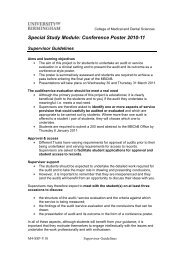Contents - College of Medical and Dental Sciences - University of ...
Contents - College of Medical and Dental Sciences - University of ...
Contents - College of Medical and Dental Sciences - University of ...
You also want an ePaper? Increase the reach of your titles
YUMPU automatically turns print PDFs into web optimized ePapers that Google loves.
The 11 th International Workshop on KSHV & Related Agents, Birmingham, UK<br />
Poster Session Abstract P10<br />
ANALYSIS METHODS FOR THE RELIABLE PREDICTION OF VIRUS AND HOST<br />
MIRNA EXPRESSION FROM THE AGILENT MIRNA MICROARRAY<br />
Eve Coulter, Dan Frampton, Paul Kellam<br />
MRC Centre for <strong>Medical</strong> Molecular Virology, Department <strong>of</strong> Infection, UCL, 46 Clevel<strong>and</strong><br />
Street, London, W1T 4JF<br />
Abstract<br />
MicroRNAs play an important role in the down-regulation <strong>of</strong> gene expression by blocking<br />
translation <strong>of</strong> their mRNA targets. Hundreds <strong>of</strong> miRNAs have been identified within the<br />
human genome, many <strong>of</strong> which are predicted to be involved in the regulation <strong>of</strong> major<br />
cellular processes such as cell development <strong>and</strong> apoptosis. It is thought their abnormal<br />
expression may contribute to cancer development <strong>and</strong> proliferation. In addition, miRNAs<br />
have been shown to be present in every herpesvirus examined to date suggesting they<br />
play a similar role in viral gene regulation.<br />
The development <strong>of</strong> suitable miRNA array technology allows us to detect the presence or<br />
absence <strong>of</strong> both human <strong>and</strong> viral miRNAs <strong>and</strong> to use miRNA pr<strong>of</strong>iles to differentiate<br />
between virus-infected <strong>and</strong> non-infected cell types. However, there is some uncertainty<br />
over the design <strong>of</strong> reliable probes for viral miRNAs, with several different probes being<br />
used to measure the level expression <strong>of</strong> a given miRNA. We have used the Agilent miR<br />
array platform <strong>and</strong> a panel <strong>of</strong> herpesvirus positive B-cell lymphomas to develop an<br />
accurate data analysis method which discards unreliable probes <strong>and</strong> show it is better able<br />
to discriminate between KSHV- <strong>and</strong> EBV-infected B-cell tumour cell lines than the<br />
st<strong>and</strong>ard Agilent method. Statistical validation was performed using ROC analysis <strong>of</strong> a<br />
large dataset <strong>of</strong> B cell tumour cell line miRNA arrays <strong>and</strong> predicted differentially<br />
expressed miRNAs confirmed by real time PCR.<br />
Presenting author Email: d.frampton@ucl.ac.uk<br />
107















